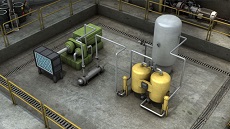
When you use a compressed air system in industrial settings, you cannot expect it to work flawlessly at all times. Different types of issues can hinder the compressor’s performance, and excess moisture is one of them. It can reduce the system’s efficiency and affect industrial operations in the long run. While the problem sounds daunting, you can deal with it using some actionable measures. Simple steps and appropriate maintenance can help you get rid of moisture in your compressed air system and optimize efficiency. Here are some measures you can rely on.
Understand the causes
Moisture is an unavoidable by-product of compressed air because air contains water vapor. The volume of vapor varies depending on the temperature and pressure. Even before you find ways to eliminate moisture, you must understand the causes leading to it. Condensation is an all-season problem for compressed air systems. But it can get a tad more troublesome during summertime when the air is hot and humid. You can expect to face it in the winter because cold temperatures reduce the efficiency of evaporation. Moisture can accumulate over time in the compression system. You need to keep an eye on the issue and resolve it at the earliest, regardless of the season.
Be aware of the potential problems
As a business owner, it is easy to overlook moisture in your compression systems initially because there aren’t any immediate issues. But excess moisture can cause problems for your compressor sooner rather than later. Corrosion is the biggest concern. It can damage the equipment, saddling you with massive costs of repair or replacement. Condensed water can block control lines and even freeze in cold weather. Ice formation causes the risk of cracking pipes and components. Keeping the Reciprocating Air Compressor clean and dry is not much effort, but it can save you from big trouble. You only need to take the issue seriously and take a proactive approach to avoid these problems.
Simple measures can go a long way
It is practically impossible to keep your air compressor moisture-free, but you can eliminate most of it. You will need to follow a series of steps to keep the system dry, with a combination of mechanical separation and the use of air dryers. Regular cleaning with solutions such as Oilers Depot can also extend the life. Condensation starts in the receiver tank, so drying it should be the first step. A manual drain valve can help in draining excess water from the system. You must do it at least once a day if draining manually. Automatic drain valves are better as you can set the timer to drain it at regular intervals. A water separator filter helps with removing large amounts of moisture with centrifugal force. You can use refrigerant or desiccant air dryers to go the extra mile.
There isn’t a one-size-fits-all solution for removing moisture from compressed air. But you can pick an apt one depending on factors such as system usage, climatic conditions at your location, and the indoor environment of the installation. It is best to consult an expert to guide you in creating a perfect system to optimize operations with clean and dry compressed air.






